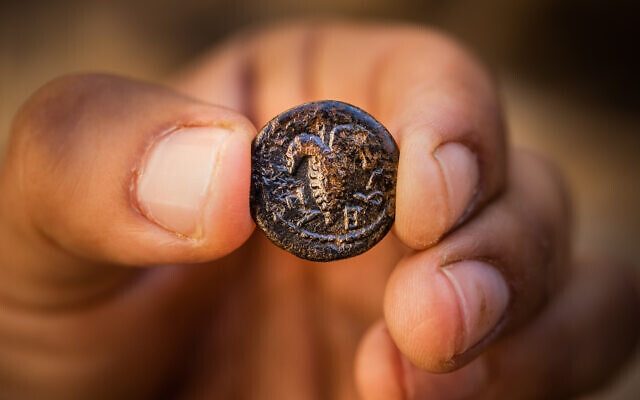TEL AVIV – A rare bronze coin dating back to the Bar Kochba revolt (circa 132 CE) was revealed by the Israel Antiquities Authority (IAA) Monday, just ahead of the Lag B’Omer holiday, which commemorates the life of anti-Roman second-century sage Rabbi Shimon bar Yochai.
Lag B’Omer is usually celebrated with large bonfires to mark both Bar Yohai’s death and those who took part in the Bar Kochba revolt against the Romans in Judea.
However, this year the government banned bonfires across the country over fears of another Chinese coronavirus outbreak.
The coin was uncovered during excavations in the William Davidson Archaeological Park, between the Temple Mount and the City of David in Jerusalem, and is embellished with a cluster of grapes and the inscription “Year Two of the Freedom of Israel.”
The other side has a palm tree and the word “Jerusalem.”
“It is possible that a Roman soldier from the Tenth Legion found the coin during one of the battles across the country and brought it to their camp in Jerusalem as a souvenir,” a statement from the IAA said.
According to Donald Tzvi Ariel, head of the Israel Antiquities Authority’s coin department, only four coins out of more than 22,000 found in the Old City have dated back to the Bar Kochba revolt.
It is also unique in that it is the only such coin to bear the inscription, “Jerusalem.”
IAA archaeologists Moran Hagbi and Dr. Joe Uziel conjectured the possibility the coins were brought to Jerusalem by Roman forces who quashed the revolt.
The Bar Kochba revolt lasted three and a half years and was the greatest Jewish revolt, although hundreds and thousands of Jews died.
Rabbi Shimon Bar Yohai fled with his son to a cave for 13 years where he eventually died on Lag B’Omer.

COMMENTS
Please let us know if you're having issues with commenting.